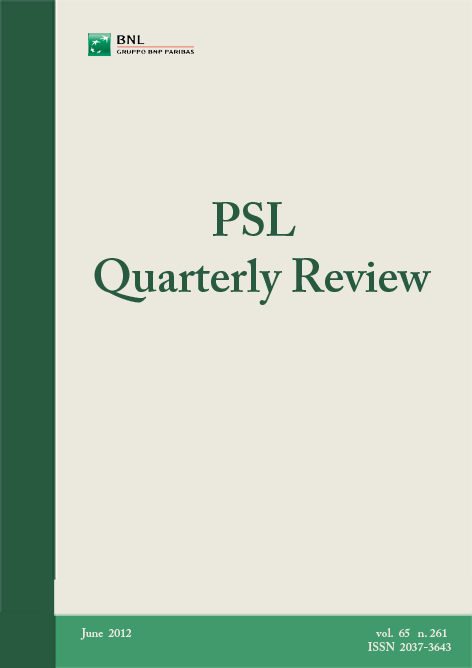Josef Steindl’s Life and Work in Austria
DOI:
https://doi.org/10.13133/2037-3643/10095Keywords:
Post-Keynesianism, Educational Policy, Technology PolicyAbstract
Josef Steindl’s impact on economic policy in Austria concentrated on three areas: Keynesian thinking, educational policy and technology policy. After returning to Vienna in 1950 Steindl advanced Keynesian and Kaleckian thinking in Austria and thus influenced a whole generation of economists. He pushed for an educational policy in Austria and emphasised the role of engineers, technicians and skilled workers in long-term economic growth. Closely related to this was his plea for a technology policy. As an industrial latecomer, Austria was able to import technologies for a long time; but once the country had caught up, it needed to stimulate innovation with a conscious technology policy.
JEL Codes: E12, I20, O33
References
BHADURI A. and STEINDL J. (1983), The Rise of Monetarism as a Social Doctrine, London: Thames Polytechnic.
CRAVER E. (1986), “The Emigration of the Austrian Economists”, History of Political Economy, vol. 18 n. 1, pp. 1-32.
GUGER A., MARTERBAUER M. and WALTERSKIRCHEN J. (2006), “Growth Policy in the Spirit of Steindl and Kalecki”, Metroeconomica, vol. 57 n. 3, pp. 428-442.
HARROD R.F. (1936), The Trade Cycle, Oxford: Clarendon Press.
KEYNES J.M. ([1933] 1972), “Essays in Biography”, in Johnson E. (ed.), The Collected Writings of John Maynard Keynes, vol. 10, London: Macmillan, pp. 161-231.
MÜLLER K. (1993), “The Ideal Worlds of the Austrian Political Economists”, in Weibel P. and Stadler F. (eds.), Vertreibung der Vernunft: The Cultural Exodus from Austria, Vienna: Löcker Verlag, pp. 153-167.
NELSON R.R. and WINTER S.G. (1982), An Evolutionary Theory of Economic Change, Cambridge, Massachusetts: Harvard University Press.
ROTHSCHILD K.W. (1987), “Roots – Reflections on Josef Steindl’s First Article in an Economic Journal”, Finance, Technical Change and Market Forms in the Accumulation Process, Centro Internazionale di Studi di Economia Politica, Trieste, September 1987.
ROTHSCHILD K.W. (1994), “Josef Steindl: 1912-1993”, The Economic Journal, vol. 104 n. 422 (Jan.), pp. 131-137.
STEINDL J. (1937), “Der Konjunkturzyklus”, Zeitschrift für Nationalökonomie, vol. 8 n. 2, pp. 229-237; republished in English, Steindl (2008).
STEINDL J. (1952), Maturity and Stagnation in American Capitalism, Oxford: Blackwell.
STEINDL J. (1956), “Wie wirkt die Ausgabe einer zusätzlichen Milliarde Schilling?”, WIFO-Monatsberichte, ‘Sonderheft’ n. 9.
STEINDL J. (1957), “Zur Berechnung der Indizes der Produktivität”, WIFO-Monatsberichte, ‘Sonderheft’ n. 11.
STEINDL J. (1965), Random Processes and the Growth of Firms. A study of the Pareto Law, London: Charles Griffin & Company Limited.
STEINDL J. (1965), “The Role of Manpower Requirements in Educational Planning: Experience of the Austrian EIP-Team”, in Forecasting in Educational Planning, Paris: OECD.
STEINDL J. (1967), Bildungsplanung und wirtschaftliches Wachstum: Der Bildungsbedarf in Österreich 4bis 1980, Studien und Analysen, n. 2, Vienna: WIFO.
STEINDL J. (1967), “Capitalism, Science and Technology”, in Feinstein C.H. (ed.), Socialism, Capitalism, and Economic Growth: Essays Presented to Maurice Dobb, Cambridge: Cambridge University Press, pp. 198-205.
STEINDL J. (1968), “Educational Planning and Economic Growth”, in Policy and Planning: Austria, Paris: OECD.
STEINDL J. (1970), “Skilled Manpower and Growth”, in Occupational and Educational Structures of the Labour Forces and Levels of Economic Development, Paris: OECD, pp. 309-317.
STEINDL J. (1970), “Natürlicher Abgang und Erneuerung von Arbeitskräften”, WIFO-Monatsberichte, vol. 43 n. 7, pp. 266-272.
STEINDL J. (1972), “Diffusion der Umsätze als Maßstab für die Dynamik einer Branche”, WIFO-Monatsberichte, vol. 45 n. 2, pp. 56-63.
STEINDL J. (1976), Maturity and Stagnation in American Capitalism, New York: Monthly Review Press.
STEINDL J. (1976), “Emigration, Ersatzbedarf und Nachwuchs von Akademikern”, WIFO-Monatsberichte, vol. 49 n. 7, pp. 307-325.
STEINDL J. (1977), “Lohndrift und Tarifpolitik in den Industriebranchen 1966-1976”, WIFO-Monatsberichte, vol. 50 n. 10, pp. 496-509.
STEINDL J. (1980), “Technical Progress and Evolution”, in Sahal D. (ed.), Research, Development and Technological Innovation, Lexington: D.C. Heath and Company, pp. 131-141.
STEINDL J. (1984), “Reflections on the Present State of Economics”, Banca Nazionale del Lavoro Quarterly Review, vol. 37 n. 148, pp. 3-14.
STEINDL J. (1985), “Betrachtungen über die Nationalökonomie heute”, Wirtschaft und Gesellschaft, vol. 11 n. 3, pp. 403-406.
STEINDL J. (1988), “Zeitzeuge”, in Stadler F. (ed.), Vertriebene Vernunft, vol. 1, Vienna: Jugend und Volk, pp. 399-401.
STEINDL J. (1988), “Diskussionsbeitrag zur EG-Frage”, Kurswechsel, vol. 4 n. 3, pp. 3-7.
STEINDL J. (1990), “From Stagnation in the 30s to Slow Growth in the 70s”, in Berg M. (ed.), Political Economy in the Twentieth Century, New York: Philip Allan, pp. 97-115.
STEINDL J. (2008), “The Trade Cycle”, Review of Political Economy, vol. 20 n. 3, pp. 341-348.
SYLOS LABINI P. (1969), Oligopoly and Technical Progress, Cambridge, Massachusetts: Harvard University Press.
Downloads
How to Cite
Issue
Section
License



